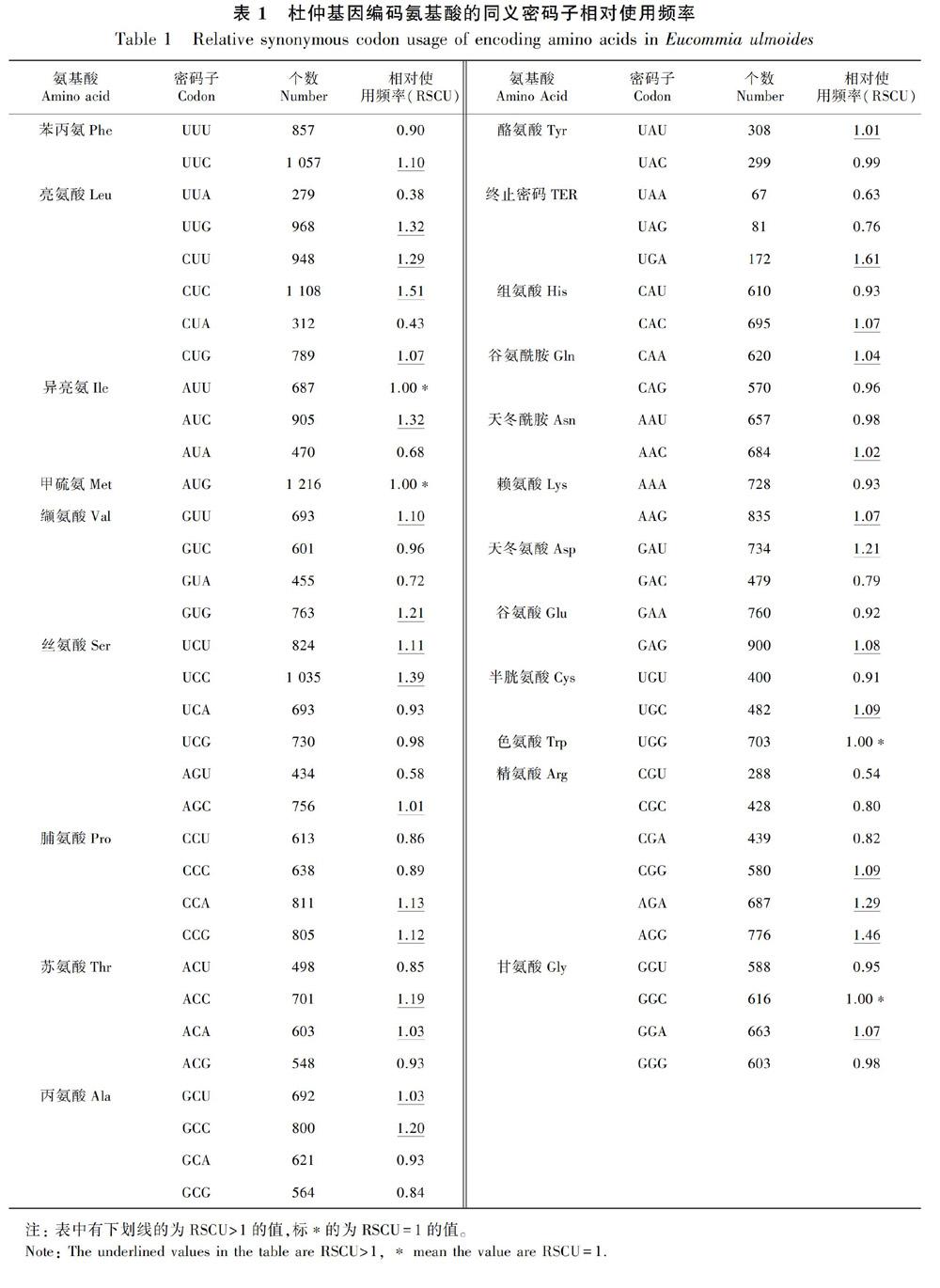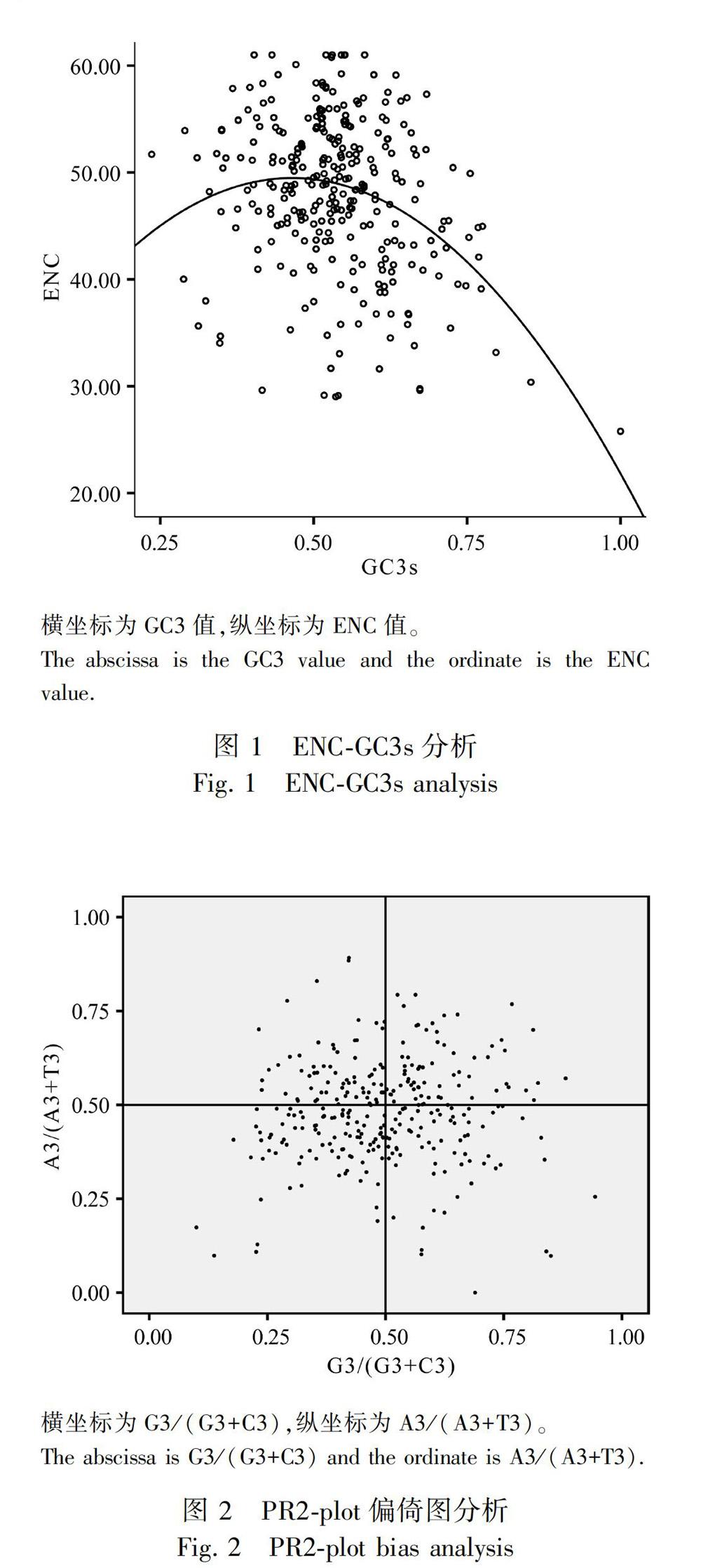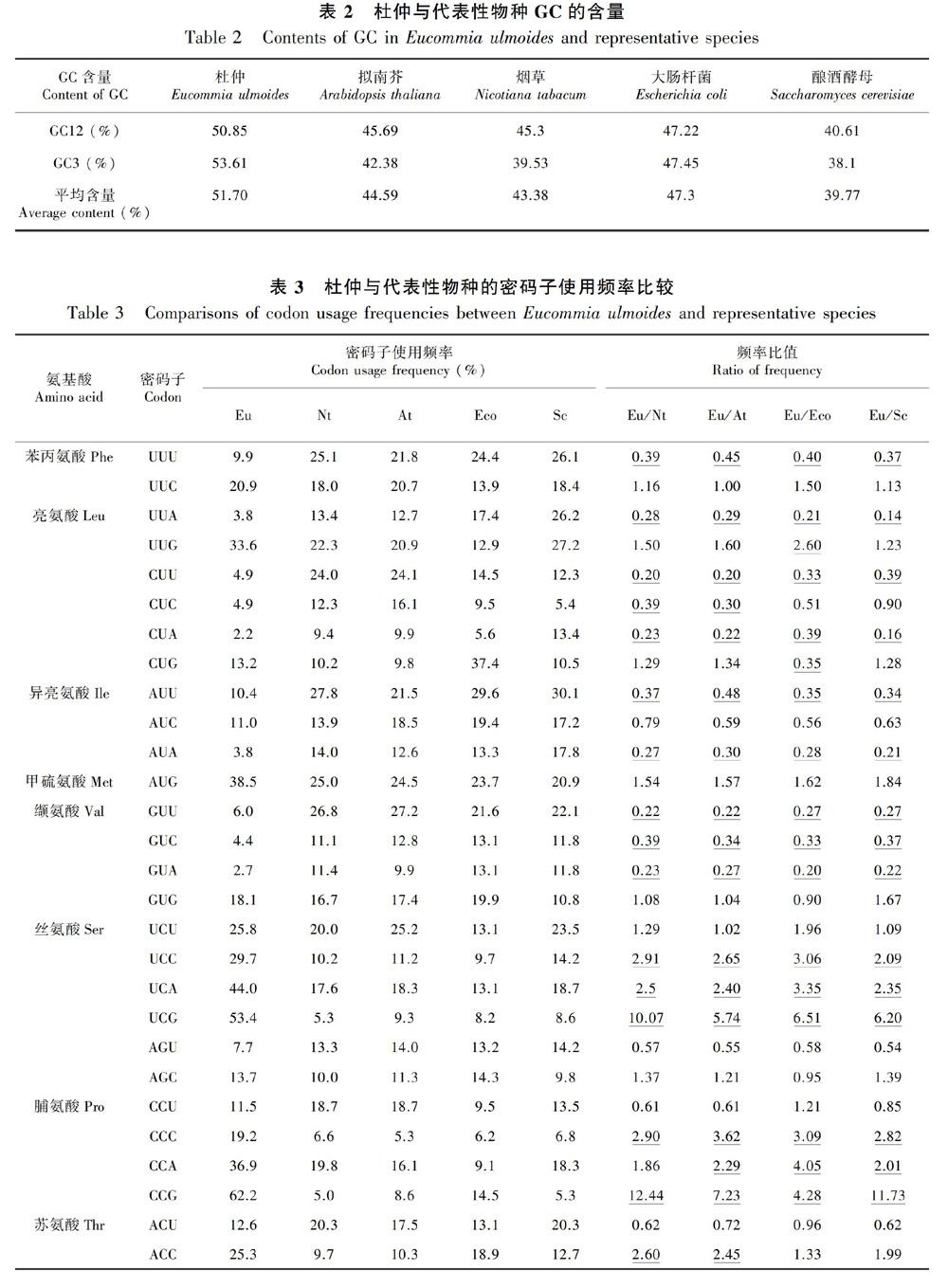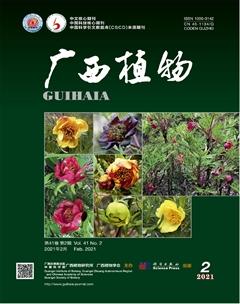杜仲基因密码子使用模式分析
王艳 赵懿琛 赵德刚



摘要:為了解杜仲基因密码子使用模式,该文以杜仲基因组密码子为研究对象,运用CodonW软件对杜仲的320个蛋白编码基因进行同义密码子相对使用频率(RSCU)分析、ENCGC3s关联分析编码基因的密码子ENC值、PR2plot偏倚分析编码基因的密码子碱基使用频率,并运用CUSP软件与Codon Usage Database软件对杜仲基因密码子的GC含量、使用频率与代表性物种烟草、拟南芥、大肠杆菌和酿酒酵母的密码子GC含量和使用频率进行比较。结果表明:杜仲基因密码子的RSCU>1的密码子有30个,其中18个以G/C结尾、12个以A/U结尾,说明杜仲基因密码子偏好以G/C结尾,且偏好性较强;有效密码子数(ENC)范围为30~60,该范围内的密码子距离标准曲线较远,其ENC值小,偏好性较强;PR2plot偏倚分析碱基使用频率显示,G>C、U>A;杜仲与代表性物种的GC含量分析显示,杜仲的GC12、GC3以及平均GC含量均高于代表性物种;杜仲与代表性物种的密码子使用频率分析显示,杜仲与烟草、酿酒酵母的密码子偏好较为接近,杜仲与拟南芥、大肠杆菌的密码子偏好差距较大。杜仲是我国特有的珍贵中药材,对其进行密码子使用模式分析,并研究其密码子偏好规律,为杜仲植物基因工程中外源基因的改良及表达提供了理论基础。
关键词: 杜仲基因, 密码子, 偏好性, 使用模式, 代表性物种
中图分类号:Q943
文献标识码:A
文章编号:10003142(2021)02027409
Abstract:To comprehend the codon usage pattern of genes in Eucommia ulmoides, taking the E. ulmoides genome codons as the research object, the 320 coding DNA sequences was analyzed to obtain the results of relative synonymous codon usage(RSCU), ENCGC3s analysis of codon ENC values of coding genes and PR2plot bias analysis of the codon base usage frequency of the coding genes. By using CUSP and Codon Usage Database software to compare the GC contents and codon occurrence frequency of E. ulmoides with those of Arabidopsis thaliana, Nicotiana tabacum, Escherichia coli and Saccharomyces cerevisiae. The results were as follows:The number of RSCU value greater than 1 had 30 codons, including 18 genes with ending G/C and 12 genes ending with A/U, and these suggested that the codons preferred ends with G/C, and had a strong bias; The number of effective codons (ENC) ranges from 30 to 60, and the codons within this range were far away from the standard curve and their ENC values were smaller and had a higher preference; PR2plot analysis showed that G>C,U>A, in the base usage frequency; Analysis of GC contents of Eucommia ulmoides and representative species showed that the E. ulmoides GC12, GC3 and average GC contents were higher than those of representative species; The analysis of the codon usage frequency of E. ulmoides and representative species showed that the codon preferences of E. ulmoides and Nicotiana tabacum, Saccharomyces cerevisiae were close, and the codon preferences of Eucommia ulmoides, Arabidopsis thaliana and Escherichia coli were quite different. Eucommia ulmoides is a precious Chinese medicinal material unique in China. Analysis ofthe codon usage pattern and studies of its codon preference will provide a theoretical basis for the improvement and expression of foreign genes in E. ulmoides plant genetic engineering.
2.2 ENC与GC3s关联分析
以杜仲基因密码子ENC值为纵坐标,GC3值为横坐标作图分析(图1)。由图1可知,杜仲基因ENC值多集中分布于30~60之间,该区域内的密码子距离标准曲线的距离远近不一,但大部分密码子距离标准曲线较远,其ENC值小,偏好性较强。
2.3 PR2plot偏倚分析
对杜仲基因密码子进行PR2plot偏倚分析,如图2所示。由图2可知,密码子多分布于平面图的下方和右方,说明碱基使用頻率为G>C、U>A。
2.4 杜仲与代表性物种的GC含量及密码子使用频率比较
将杜仲与4种代表性物种的GC含量进行比较,如表2所示。由表2可知,杜仲基因密码子的平均GC含量最高为51.7%,密码子第三位碱基GC含量也最高,为53.61%,说明杜仲基因密码子偏好GC结尾。其次为大肠杆菌、拟南芥、烟草和酿酒酵母。杜仲与代表性物种的密码子使用频率以及频率比值结果如表3所示,由表3可知,杜仲与代表性物种的密码子使用频率比值≥2或≤0.5的分别有31、34、34、32个,该值说明两物种间对该密码子的使用偏差。表3中杜仲与大肠杆菌和拟南芥的密码子使用偏好具有明显差异,而杜仲与烟草、酿酒酵母的密码子偏好性差别较小。若要为杜仲基因寻找宿主表达系统的话,可选择烟草或酿酒酵母较为合适。
3讨论与结论
氨基酸由三联体密码子编码,密码子简并性可使碱基第三位改变的情况下编码正确的氨基酸,保证蛋白质合成的准确。不同生物的密码子使用偏好存在差异,即便同一生物不同基因的密码子使用偏好也存在差异(吴宪明等,2007)。密码子使用偏好是生物在进化过程中突变、选择的综合结果,研究表明密码子偏好与基因表达水平相关,高表达基因倾向使用最优密码子(赵洋等,2011)。密码子偏好性也反应了生物间进化的关系,可作为生物进化关系的参考(陈哲等,2017)。密码子使用模式分析可为生物的外源基因插入及表达提供一定的理论依据(罗洪等,2015)。杜仲是我国特有的珍贵药材,具有降血压、安胎等功效。但因其为木本植物、生长周期长等原因,杜仲遗传转化不易进行且转基因杜仲移栽至土里存活率不高。因此,探究杜仲基因的密码子使用模式可为杜仲的遗传转化提供更多可能性。
本研究以杜仲基因组为对象,分析杜仲基因密码子使用模式。结果表明杜仲基因密码子RSCU>1的有30个,其中18个密码子以G/C结尾、12个密码子以A/U结尾,说明杜仲基因密码子偏好以G/C结尾,这种偏好可能是由于以 G/C结尾的密码子具有较高的结合能,有利于保证翻译的准确性 (蒋玮等,2014)。ENC值大小可量化一个基因的密码子使用频率与同义密码子平均使用频率的偏差,从而检测单个基因密码子的偏好程度(朱婷婷等,2017)。ENC值与期望ENC值差异越小,说明突变对密码子偏好性影响越大;ENC值与期望ENC值差异越大,说明选择对密码子偏好性影响越大(杨国锋等,2015)。分析杜仲基因密码子ENC值,其值集中分布于30~60间,且该区域内的密码子距离标准曲线较远,偏好性较强。PR2plot分析中,平面图显示各基因的碱基组成,其中点代表无偏倚性使用时的密码子状态,即A=U,G=C(尚明照等,2011;邢朝斌等,2013)。杜仲基因密码子的PR2plot分析显示碱基使用频率为G>C、U>A。说明杜仲基因密码子的使用偏好受到自然选择和基因突变的影响。杜仲与拟南芥、烟草、大肠杆菌、酿酒酵母等代表性物种的密码子使用频率都具有不同程度的差异,若这些生物的基因要在杜仲中表达,则应先进行密码子优化。杜仲与烟草、酿酒酵母的密码子偏好性差别较小,与大肠杆菌、拟南芥的密码子偏好性差别较大。如果烟草、酿酒酵母的基因要在杜仲中表达则只需优化个别密码子,若要为杜仲基因寻找宿主系统,则烟草、酿酒酵母较为合适。
随着基因工程的广泛应用,外源基因的功能验证多采用转基因异源表达。外源基因导入宿主系统后由于其密码子与宿主系统的密码子使用偏好不同,导致表达效率低下。密码子偏好性分析在基因异源表达方面具有重要意义,基于同义密码子的使用频率不同,为了提高外源基因的表达水平,可对稀有密码子进行改造,增加优势密码子使用频率使得外源基因更好地表达(胡晓艳等,2019)。本研究分析珍贵中药材杜仲的基因密码子使用模式,对于杜仲中外源基因的插入及高效表达具有重要意义并提供了理论基础。
参考文献:
CHAO YE, CHANG Y, WANG MF, 2012. Codon usage bias and cluster analysis on chloroplastic genes from seven crop species [J]. Acta Agric BorealSin, 27(4): 60-64.[晁岳恩, 常阳, 王美芳, 2012. 7种作物叶绿体基因的密码子偏好性及聚类分析 [J]. 华北农学报, 27(4):60-64.]
CHEN Z, HU FC, WANG XH, et al., 2017. Analysis of codon bias of Ananas comosus with genome sequencing data [J]. J Fruit Sci, 34(8): 946-955.[陈哲, 胡福初, 王祥和, 等, 2017. 菠萝密码子使用偏好性分析 [J]. 果树学报, 34(8):946-955.]
DING YQ, 2017. Transformed EuCHIT1 gene in wheat (Triticum aestivum) enhances resistance to stripe rust and leaf rust [D]. Guiyang: Guizhou University: 21.[丁延庆, 2017. 利用杜仲几丁质酶基因EuCHIT1创制抗锈病小麦新种质的研究 [D]. 贵阳:贵州大学:21.]
GUO LX, DONG X, ZHAO DG, 2016. Transgenic tomato plants expressing a Eucommia ulmoides chitinase gene EuCHIT1 and their resistance to Botrytis cinerea[J]. Plant Physiol J, 52(5): 703-714.[郭林霞, 董旋, 赵德刚, 2016. 转杜仲几丁质酶基因EuCHIT1番茄提高对灰霉病的抗性研究 [J]. 植物生理学报, 52(5):703-714.]
HU GB, ZHANG SL, XU CJ, 2006. Analysis of codon usage between different citrus species [J]. J S Chin Agric Univ, 27(1): 2-3.[胡桂兵, 张上隆, 徐昌杰, 2006. 不同种类柑橘的密码子用法分析 [J]. 华南农业大学学报, 27(1):2-3.]
HU XY, XU YQ, HAN YZ, et al., 2019. Codon usage bias analysis of the chloroplast genome of Ziziphus jujuba var. spinosa [J]. J For Environ, 39(6): 621-628.[胡晓艳, 许艳秋, 韩有志, 等, 2019. 酸枣叶绿体基因组密码子使用偏性分析 [J]. 森林与环境学报, 39(6):621-628.]
HU ZM, WAN Q, LI H, et al., 2019. Analysis of codon usage features of CsNRT1.1 gene in Camellia sinensis [J]. Jiangsu J Agric Sci, 35(4): 896-903.[胡振民, 万青, 李欢, 等, 2019. 茶树CsNRT1.1基因密码子使用特性分析 [J]. 江苏农业学报, 35(4):896-903.]
JIANG W, L BB, HE JH, et al., 2014. Codon usage bias in the straw mushroom Volvariella volvacea [J]. Chin J Biotechnol, 30(9): 1424-1435.[蒋玮, 吕贝贝, 何建华, 等, 2014. 草菇密码子偏好性分析 [J]. 生物工程学报, 30(9):1424-1435.]
LEI H, LI G, WANG NY, 2019. Analysis of codon usage bias in the chloroplast genome of Trollius chinensis Bunge [J]. J Shanxi Agric Sci, 47(8): 1300-1305.[雷慧, 李鸽, 王娜玉, 2019. 金莲花叶绿体基因组密码子偏好性分析 [J]. 山西农业科学, 47(8):1300-1305.]
LI Y, KUANG XJ, SUN C, 2016. Analysis of codon usage bias based on Fritillaria cirrhosa transcriptome [J]. Chin J Chin Mat Med, 41(11): 3-5.[李滢, 匡雪君, 孙超, 2016. 川贝母转录组密码子使用偏好性分析 [J]. 中国中药杂志, 41(11):3-5.]
LIU QP, DOU SJ, JI ZJ, et al., 2005. Synonymous codon usage and gene function are strongly related in Oryza sativa [J]. Biosystems, 80(2): 123-131.
LUO H, HU SS, WU Q, et al., 2015. Analysis of buckwheat chloroplast gene codon bias [J].Genomic Appl Biol, 34(11): 2457-2464.[罗洪, 胡莎莎, 吴琦, 等, 2015. 甜荞叶绿体基因密码子偏爱性分析 [J]. 基因組学与应用生物学, 34(11):2457-2464.]
PAMELA M, SURAJIT B, TAPASH CG, 2007. Nature of selective constraints on synonymous codon usage of rice differs in GCpoor and GCrich genes [J]. Gene, 400(1): 3-13.
SHANG MZ, LIU F, HUA JP, et al., 2011. Analysis on codon usage of chloroplast genome of Gossypium hirsutum [J]. Sci Agric Sin, 44(2): 245-253.[尚明照, 刘方, 华金平, 等, 2011. 陆地棉叶绿体基因组密码子使用偏性的分析 [J]. 中国农业科学, 44(2):245-253.]
SOPHIARANI Y, ARIF U, SUPRIYO C, 2019. Deciphering codon usage patterns and evolutionary forces in chloroplast genes of Camellia sinensis var. assamica and Camellia sinensis var. sinensis in comparison to Camellia pubicosta [J]. J Integr Agric, 18(12): 2775-2780.
SUBRAMANIAN S, 2008. Nearly neutrality and the evolution of codon usage bias in eukaryotic genomes [J]. Genetics, 178(4): 2429-2432.
SU H, LI YG, TAN WY, 2015. Analysis of codon usage bias and optimization of codon of gdhA gene in Escherichia coli [J]. Genomic Appl Biol, 34(3): 521-529.[苏惠, 李永光, 谭文雍, 2015. 大肠杆菌gdhA基因的密码子偏好性分析及优化 [J]. 基因组学与应用生物学, 34(3):521-529.]
WANG WD, ZHAO DG, ZHAO YC, 2018. Cloning and sequence analysis of Dirigent protein coding genes from Eucommia ulmoides [J]. Genomic Appl Biol, 37(3): 1293-1301.[王维东, 赵德刚, 赵懿琛, 2018. 杜仲Dirigent蛋白编码基因的克隆及序列分析 [J]. 基因组学与应用生物学, 37(3):1293-1301.]
WANG XX, WU L, ZHOU P, et al., 2013. Analysis of synonymous codon usage patterns in the genus Rhizobium [J]. World J Microbiol Biotechnol, 29(11): 2015-2024.
WANG Y, DONG X, ZHAO DG, 2015. Molecular cloning and analysis of EuREF1 involved into rubber biosynthesis in Eucommia ulmoides Olive [J]. Genomic Appl Biol, 34(5):917-925.[王宇, 董旋, 赵德刚, 2015. 杜仲胶合成相关基因EuREF1的克隆及分析 [J]. 基因组学与应用生物学, 34(5):917-925.]
WU XM, WU SF, REN DM, et al., 2007. The analysis method and progress in the study of codon bias [J]. Hereditas, 29(4): 420-426.[吳宪明, 吴松锋, 任大明, 等, 2007. 密码子偏性的分析方法及相关研究进展 [J]. 遗传, 29(4):420-426.]
XING ZB, CAO L, ZHOU M, et al., 2013. Analysis on codon usage of chloroplast genome of Eleutherococcus senticosus [J]. Chin J Chin Mat Med, 38(5): 661-665.[邢朝斌, 曹蕾, 周秘, 等, 2013. 刺五加叶绿体基因组密码子的用法分析 [J]. 中国中药杂志, 38(5):661-665.]
YANG GF, SU KL, ZHAO YR, et al., 2015. Analysis of codon usage in the chloroplast genome of Medicago truncatula [J]. Acta Pratac Sin, 24(12): 171-179.[杨国锋, 苏昆龙, 赵怡然, 等, 2015. 蒺藜苜蓿叶绿体密码子偏好性分析 [J]. 草业学报, 24(12):171-179.]
ZHANG WJ, 2006. Codon analysis and its application in bioinformaties and evolutionary studies [D]. Shanghai: Fudan University: 20.[张文娟, 2006. 基于密码子水平的生物信息学分析及进化研究 [D]. 上海:复旦大学:20.]
ZHAO CL, PENG LY, WANG X, et al., 2019. Codon bias and evolution analysis of AtGAI in Amaranthus tricolor L. [J]. J Chin Agric Univ, 24(12): 10-22.[赵春丽, 彭丽云, 王晓, 等, 2019. 苋菜AtGAI基因密码子偏好性与进化分析 [J]. 中国农业大学学报, 24(12):10-22.]
ZHANG YL, YANG GQ, GUO Y, 2002. Expression of bovine protamine gene optimized by codon in E. coli [J]. Chin High Technol Lett, 12(4): 42-46.[张雅丽, 杨国庆, 郭英, 2002. 密码子优化的牛精蛋白基因在大肠杆菌中的表达 [J]. 高技术通讯, 12(4):42-46.]
ZHAO Y, YANG Y, LIU Z, et al., 2011. Analysis of codonusage in tea plant (Camellia sinensis) [J]. J Tea Sci, 31(4): 319-325.[赵洋, 杨阳, 刘振, 等, 2011. 茶树密码子用法分析 [J]. 茶叶科学, 31(4):319-325.]
ZHU TT, ZHANG L, CHEN WS, et al., 2017. Analysis of chloroplast genomes in 1342 plants [J]. Genomic Appl Biol, 36(10): 4323-4333.[朱婷婷, 张磊, 陈万生, 等, 2017. 1342 个植物叶绿体基因组分析 [J]. 基因组学与应用生物学, 36(10):4323-4333.]
(责任编辑周翠鸣)

